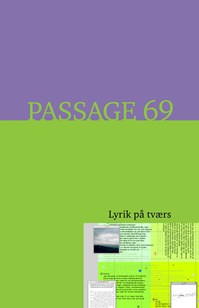Det multimodale ikon
DOI:
https://doi.org/10.7146/pas.v28i69.17580Nøgleord:
Syn, lyn, kognition, poesi, multimodalResumé
I den indledende artikel af Joseph M. Conte, “Det multimodale ikon: Syn, lyd og kognition i nyere poesi”, opridses poesiens historie frem til i dag med udgangspunkt i den tese, at der er sket et skift i den måde, hvorpå vi afkoder poesi. Mens man tidligere
opfattede poesi som en kunstart, der kun udtrykte sig i én kode, nemlig bogstaverne på bogsiden, er digtet i den digitale tidsalder blevet et multimodalt ikon, i hvilket tekst og billede samvirker i betydningsdannelsen på en kompleks måde. Hvis fortolkeren skal være på højde med den nyeste poesi, kræver det ifølge Conte
således også nye tilgange og kompetencer.
Joseph M. Conte: “The Multimodal Icon: Sight, Sound and Intellection in Recent Poetries”
This article examines the shift from single to multiple semiotic modes in poetry during the age of digital media. While one can argue that in the history of poetry the text has always represented “sight, sound and intellection,” the propagation of digital media and the devolution of popular culture into a predominantly graphical regime have made an irrevocable impression on poetry on-the-page. The production of multimodal poetry in print literature presents the hybridization of text and image, or typography and the visual arts. In the multimodal poetry of Emily McVarish,
Steve McCaffery and Geof Huth, the reader encounters two or more semiotic modes simultaneously. The relation between text and image is not one of dependency or autonomy but rather a bilateral interactivity that requires and stimulates a cognitive poetics. Such print works demand that readers pursue a multiplicity of reading
paths and develop the interpretive skills required by multimodal metaphor in which signs are drawn from more than one mode.
Downloads
Publiceret
Citation/Eksport
Nummer
Sektion
Licens
Forfattere, der publicerer deres værker via dette tidsskrift, accepterer følgende vilkår:
- Forfattere bevarer deres ophavsret og giver tidsskriftet ret til første publicering, samtidigt med at værket efter publiceringen er omfattet af en Creative Commons Attribution-licens, der giver andre ret til at dele værket med en anerkendelse af værkets forfatter og første publicering i nærværende tidsskrift.
- Forfattere kan indgå flere separate kontraktlige aftaler om ikke-eksklusiv distribution af tidsskriftets publicerede version af værket (f.eks. sende det til et institutionslager eller udgive det i en bog), med en anerkendelse af værkets første publicering i nærværende tidsskrift.
- Forfattere har ret til og opfordres til at publicere deres værker online (f.eks. i institutionslagre eller på deres websted) forud for og under manuskriptprocessen, da dette kan føre til produktive udvekslinger, samt tidligere og større citater fra publicerede værker (se The Effect of Open Access).





